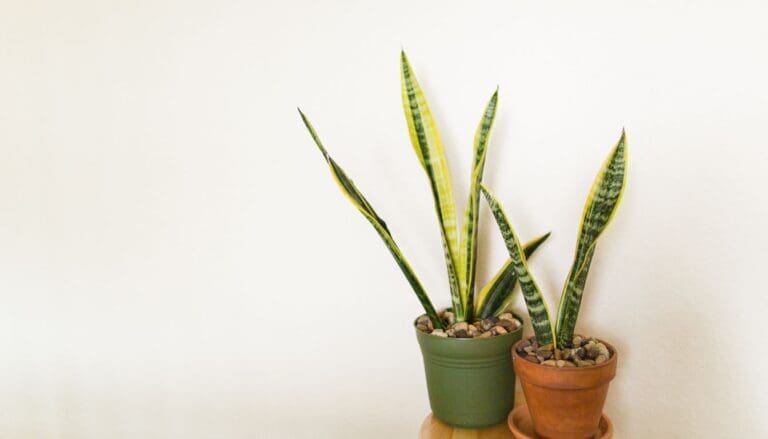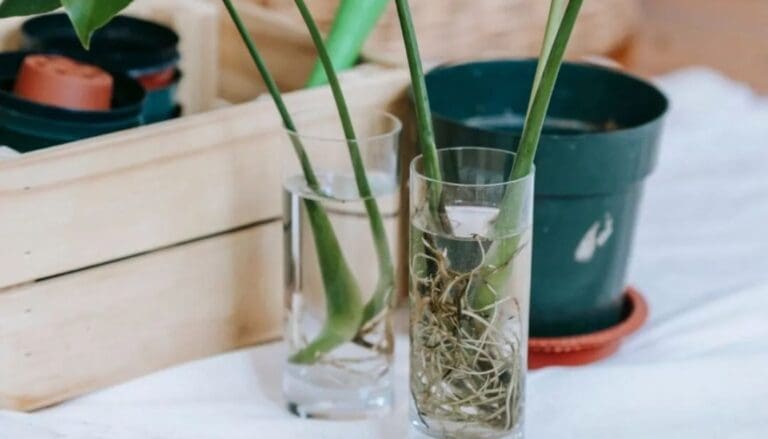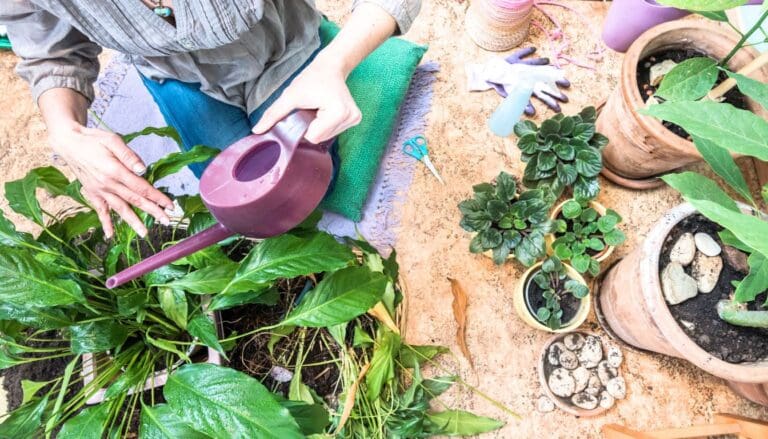Does English Ivy Like To Be Misted? (+Ideal Humidity Guide)
English ivy is a popular vining plant that you will find in the gardens and indoor spaces. Many people mist their plants to increase the humidity levels, but does English ivy like to be misted? Let’s find out.
English ivy likes to be misted as it helps them get more humidity and keeps the leaves clean. Mist your English ivy 2-3 times every week. However, if you are misting your ivy, keep it in a well-ventilated space. Otherwise, misting can attract pests and cause fungal diseases.
If you don’t know whether your English ivy is getting enough humidity, use a humidity monitor to check the humidity levels around it.
In this article, we will discuss misting and the humidity requirements of an English ivy plant. If you own an English ivy or plan to get one, reading this article will help you take better care of it.

Please note: Simplify Plants is reader-supported. Some links in the post are affiliate links and I get a commission from purchases made through links in the post.
Does English ivy like humidity?
English ivy likes medium to high humidity levels to thrive.
The minimum humidity requirement of English ivy plants is between 40-50%.
Most households will provide the required humidity, so you won’t need to do anything extra.
But, if you live in an area where the air remains dry or growing English ivy in an air-conditioned space, you will need to take steps to increase the humidity.
Should I mist my English ivy?
There is divided opinion about this in the houseplant community.
While some say that misting their houseplants is a must, some don’t prefer misting at all.
I spoke with a few experts about this, and here’s the difference in the opinions about misting.
| Misting supporters | Misting opposers |
|---|---|
| It helps to increase the humidity levels. | It increases the humidity only for a short while. |
| It helps the leaves remain clean and shiny. | It can damage the leaves if the water droplets don’t evaporate. |
| It helps prevent pests if you use a Neem oil solution to mist your plant. | It can increase the chances of pest infestations and fungal diseases. |
I don’t think misting will cause any problem if your plant stays in favorable conditions.
If the humidity is already enough, or the plant is not getting proper airflow around it, it will face issues.
So be careful if you decide to mist your English ivy.
Don’t let the water droplets remain on the leaves for too long.
If you don’t see them evaporate, you can clean them with a microfibre cloth.
Also, avoid misting if the ventilation is not good around your English ivy.
However, I agree that misting doesn’t increase the humidity for too long.
If you are misting your English ivy to increase the humidity levels, there are other options that you can consider for a more long-term solution.
How to check the humidity of the room?
Many people don’t know their rooms’ humidity levels and assume they are low or high.
Due to this, they end up providing too much or too little humidity to their houseplants.
Don’t commit this mistake and check the humidity levels before taking any measures.
Use a hygrometer to check the humidity.
You will easily get one in the market or online.
These small portable devices tell you the room’s relative humidity levels.
Different rooms have different humidity levels, so a hygrometer will help you determine the humidity of the different rooms of your house.
If you keep your English ivy in the bathroom or the laundry room, you might not need to provide extra humidity as these rooms already have enough humidity.
So, getting a hygrometer will help you understand the humidity levels of each room.
These are available at affordable rates. So you can get one easily.
Signs your English ivy needs more humidity.

Plants show signs when they don’t get everything that they need or are living in unfavorable conditions.
If your English ivy is not getting enough humidity, it will show certain signs:
- Droopy leaves
- Crispy edges on leaves
- Yellow leaves
- Wilting leaves
- Brown leaves
- Slow growth
These signs can indicate other problems too.
So before you conclude, check the humidity levels with a hygrometer around your English ivy.
How to increase the humidity for English ivy?
If the humidity around your English ivy is low, you need to find a way to increase it.
Misting is the easiest way of adding humidity to your plants.
Some even use pebble trays to increase the humidity.
- In this process, you take a tray and put some pebbles.
- Now, add water to the tray.
- Keep the ivy on top of the pebbles.
- Ensure the water doesn’t get inside the pot through the drainage holes.
When the water evaporates, the humidity around the plant will increase.
You must add water to the tray when the water level goes down.
But since these are not long-term solutions, I have listed some ways to boost the humidity with less input from you.
You can still mist your English ivy a few times a week.
Now, let’s understand the different ways of increasing the humidity levels.
1. Relocate your English ivy
As discussed earlier, many rooms in your house don’t have enough humidity.
But rooms like the bathroom, basement, kitchen, and laundry rooms have more humidity than the others.
If your English ivy is not getting enough humidity, move it to any of these rooms to increase the humidity around it.
However, be careful of the following:
- If you are relocating your ivy to the bathroom, avoid splashing water on the leaves and ensure there’s enough light.
- If you are moving the ivy to the kitchen, keep it away from heating sources like ovens.
- And if you are shifting the ivy to the basement, keep it away from the furnace.
2. Use a humidifier
Using a humidifier is the best way to increase the humidity in areas that don’t have enough moisture in the air.
A humidifier is a portable device with different sizes available, so get one that suits your requirements.
These are available at affordable rates online and in the market.
Investing in a good-quality humidifier will help your plants thrive.
You need to add water to the device and switch it on, which will turn the water into moisture and emit it to the surrounding.
A humidifier is ideal if your house gets humidity levels lower than 40-50%.
3. Group your English ivy with moisture-loving houseplants
Grouping your English ivy with other houseplants is an easy way of increasing the humidity levels.
When you keep houseplants together, they transpire and release moisture in the environment, increasing the humidity levels in the surrounding.
But, make sure you keep the plants in a ventilated space.
Also, only group humidity-loving plants.
Plants that don’t need a lot of humidity will attract pests or develop fungal diseases if you group them with humidity-loving plants.
4. Add a moss pole
Climbing plants like English ivy can get support for growing in pots if you use a moss pole.
A moss pole is a strong pole that is covered with moss.
These are mainly used for supporting plants but can also increase the humidity levels.
There are different sizes of moss poles available in the market, so you can get one that works for your ivy.
5. Add an aquarium

If you already have an aquarium, good news for your English ivy.
If you don’t have one, you can easily get a small or medium-sized one for the room.
The aquarium’s water keeps evaporating throughout the day, which increases the humidity levels around it.
If you place your English ivy near the aquarium, it will automatically get more humidity than the other areas of the house.
The aquarium water is also a great source of Nitrogen due to the accumulation of fish poop.
You can use this water to fertilize your houseplants and give them a boost of Nitrogen that can speed up their growth.
6. Add an indoor greenhouse
Mini-greenhouses are an effective way of adding more humidity to your houseplants.
These are designed for plants that require more humidity, and you can get them online or in the markets.
These are made of glass or plastic and are perfect if you live in dry regions.
These not only increase the humidity for your houseplants but also act as great home decors.
7. Use bowls of water
Placing some bowls around your English ivy is an easy way to provide humidity.
You need to take some bowls, fill them with water, and place them around your ivy.
As the water evaporates, it will add humidity to your English ivy.
This is an alternative to pebble trays, but I think this is easier than arranging a pebble tray.
8. Reduce the room temperature
If you reside in an arid region, lowering the room temperatures can help the houseplants retain more moisture.
You can use this way to increase the humidity for your English ivy if the other methods are impossible for you to execute.
Final thoughts

English ivy enjoys being misted, but misting will not be the right fit if you are looking for a long-term solution for humidity. You can mist your ivy and use a humidifier or any of the ways I have discussed above.
Misting will not suffice for the humidity alone. If you consider misting, make sure the area is well-ventilated. Mist with a Neem oil solution to prevent pests, and use a cloth to wipe the water droplets if they don’t dry naturally.
Never mist at night as that will lead to pest infestations or fungal infections. Mist your plant with room-temperature water to avoid shocking it.
Reference: Researchgate, University of Tennessee, Mississippi State University, Central Florida Research and Education Center, U.S. DEPARTMENT OF AGRICULTURE.
Recommended Garden Supplies
| Product Image | Our Recommended Gardening Supplies | Check Offers! |
|---|---|---|
Top Top
Top
Top
Top
Top
Top
Top
Top | rePotme Houseplant and Tropical Classic Potting Soil Mix | Check Offer On Amazon |
 Top
Top
Top
Top
Top
Top
Top
Top | Espoma Organic Indoor Plant Food | Check Offer On Amazon |
 Top
Top
Top
Top
Top
Top
Top
Top | GooingTop LED Grow Light 6000K Full Spectrum Clip Plant Growing Lamp | Check Offer On Amazon |
 Top
Top
Top
Top
Top
Top
Top
Top | Soil Moisture Meter | Check Offer On Amazon |
 Top
Top
Top
Top
Top
Top
Top
Top | Govee Hygrometer Thermometer, Bluetooth Enabled! | Check Offer On Amazon |
 Top
Top | LEVOIT Humidifiers for Large Room(Best For Plants) | Check Offer On Amazon |
 Top
Top
Top
Top
Top
Top
Top
Top | Upgraded DIY Automatic Drip Irrigation Kit, 15 Potted Houseplants Support | Check Offer On Amazon |
 Top
Top
Top
Top
Top
Top
Top
Top | Stainless Steel Heavy Duty Gardening Tool Set | Check Offer On Amazon |
 Top
Top
Top
Top
Top
Top
Top
Top | Bonide Insecticidal Soap | Check Offer On Amazon |
 Top
Top
Top
Top
Top
Top
Top
Top | Bonide 32 oz Spray Neem Oil for Organic Gardening | Check Offer On Amazon |
 Top
Top
Top
Top
Top
Top
Top
Top | Garden Safe Fungicide | Check Offer On Amazon |







